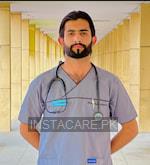Ankylosing Spondylitis - Symptoms, Risk factors and Treatment
Last Updated On Friday, December 19, 2025
Ankylosing Spondylitis in Urdu
Ankylosing spondylitis ریڑھ کی ہڈی کے جوڑوں میں ایک سوزش کی بیماری ہے۔ یہ پورے جسم کو متاثر کر سکتا ہے لیکن بنیادی طور پر ریڑھ کی ہڈی کو متاثر کرتا ہے۔ Ankylosing spondylitis vertebrae کو فیوز کرنے کا سبب بن سکتا ہے، جس سے ریڑھ کی ہڈی کی خرابی ہوتی ہے۔
Ankylosing spondylitis ایک سوزش والی حالت ہے جو بنیادی طور پر ریڑھ کی ہڈی کو متاثر کرتی ہے۔ یہ پریشان کن ہو سکتا ہے، لیکن جسمانی تھراپی اور مناسب علاج کے ساتھ، یہ بہتر ہو سکتا ہے اور زندگی کے معیار کو بہتر بنا سکتا ہے۔ اگر آپ کو ankylosing spondylitis کی کوئی علامت نظر آتی ہے، تو یہ مشورہ دیا جاتا ہے کہ اپنے ڈاکٹر سے ملیں۔
Ankylosing Spondylitis in English
Ankylosing spondylitis is an inflammatory disease in the joints of the spine. It can affect the entire body but primarily affects the spine. Ankylosing spondylitis can cause the vertebrae to fuse, causing spine deformities.
What causes ankylosing spondylitis?
The exact cause of ankylosing spondylitis is unknown. Some factors can increase the risk of developing ankylosing spondylitis.
Risk factors for getting ankylosing spondylitis:
The risk factors that can predispose a person to develop ankylosing spondylitis are:
Age: Ankylosing spondylitis more commonly occurs in young people, mostly before the age of 30.
Gender: Ankylosing spondylitis is more common in men than in women.
Genetic makeup: It is found that people who have the HLA-B27 gene are at a higher risk of getting ankylosing spondylitis and other autoimmune conditions.
Symptoms of ankylosing spondylitis:
The symptoms of ankylosing spondylitis include:
Back Pain: The symptoms of ankylosing spondylitis develop gradually and begin with backache. The pain is dull and aching and can come and go.
Other than back pain, other symptoms can include:
- Back stiffness
- Neck pain
- Fever
- Fatigue
- Weight loss
- Loss of movement in the spine
- Loss of chest expansion
- Trouble breathing deeply
Diagnosis of ankylosing spondylitis:
To diagnose ankylosing spondylitis, your doctor may ask for a detailed history of previous inflammatory conditions and do a physical exam. Other than that, your doctor may suggest the following tests:
- X-ray
- CT scan
- MRI
- Blood tests
- Genetic testing for HLA-B27
- BASDAI (Bath ankylosing spondylitis disease activity index) test
Complications of ankylosing spondylitis:
The complications of ankylosing spondylitis include:
Fusion of vertebrae: In an attempt to repair and heal the inflammation, the body forms a new bone that connects the two vertebrae causing it to become rigid and inflexible.
Poor chest expansion: Fusion of the bone can also occur between the ribs and the spine and between ribs and the breastbone (sternum), limiting chest expansion and causing breathing difficulties.
Fractures: The vertebrae in ankylosing spondylitis become weak and can get fractured. Fractured vertebrae can injure and compress the spinal cord causing numbness, loss of sensation, or paralysis in a part of the body.
People with ankylosing spondylitis can also experience complications other than these, in which other areas of the body become affected. The association of these conditions with ankylosing spondylitis is believed to be due to HLA-B27:
- Uveitis ( inflammation of the eyes)
- Inflammation of the aorta
- Aortic valve insufficiency
- Fibrosis of the lungs
Treatment of ankylosing spondylitis:
The treatment of ankylosing spondylitis may involve:
Pain medications: Pain medications, mostly NSAIDS (Non-steroidal anti-inflammatory drugs), are given, such as ibuprofen, naproxen, etc.
- Other medications may include:
- Disease-modifying antirheumatic drugs (DMARDs)
- Tumor necrosis factor-alpha blockers
- Anti-interleukin 6 inhibitors
Other than medications, surgery and physical therapy may be recommended to treat ankylosing spondylitis.
Conclusion:
Ankylosing spondylitis is an inflammatory condition that primarily affects the spine. It can be bothersome, but with physical therapy and proper treatment, it can get better and can improve quality of life. If you notice any symptoms of ankylosing spondylitis, it is advisable to see your doctor.









